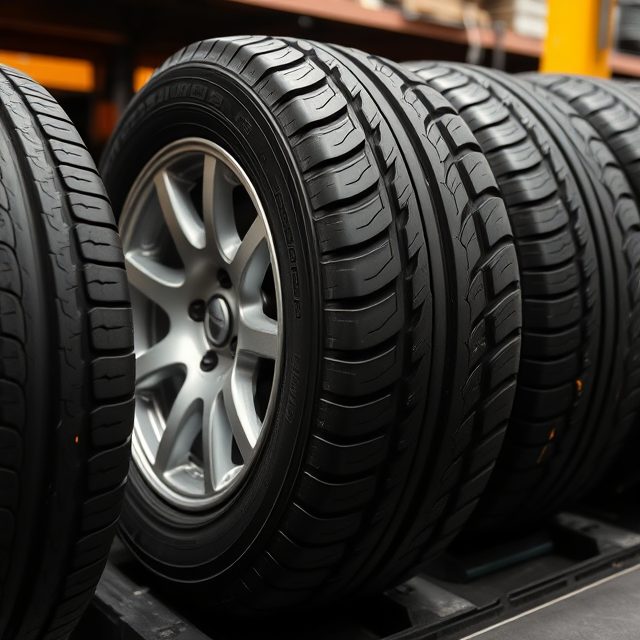How Quality Tires Affect Fuel Efficiency
Rising fuel prices have become one of the biggest concerns for drivers today. As car owners
search for effective ways to reduce their expenses at petrol stations, understanding the impact
of tires on fuel consumption becomes crucial. This article aims to provide a comprehensive
guide on how tires affect fuel efficiency and what steps we can take to make our driving
experience more economical.
Impact of Tires on Fuel Consumption—What Does It Depend On?
Many drivers are unaware of the close link between tires and fuel consumption levels. Several
factors determine how the right tires can help reduce fuel bills. These factors include tire size,
tire pressure, rolling resistance, tire tread, tire wear, and the overall tire structure.
Tire Size
The size of the tire plays a significant role in fuel consumption. Larger tires generally have
higher rolling resistance, which can lead to increased fuel consumption. On the other hand,
narrower tires can reduce rolling resistance and improve fuel efficiency. For instance, a
difference of just one centimeter in tire width can affect wind resistance and, consequently, fuel
consumption.
Tire Pressure
Keeping the tire pressure at the proper level is essential for fuel economy.Under-inflated tires
create more rolling resistance, which means the engine has to work harder to keep the car
moving. Regularly checking and maintaining the recommended tire pressure can lead to
substantial fuel savings.
Rolling Resistance
Rolling resistance is the resistive force that a tire encounters when rolling on a surface. This
force opposes the direction of motion and slows the vehicle down. The greater the rolling
resistance, the more energy the car needs to stay in motion, leading to increased fuel
consumption. Tires with lower rolling resistance can significantly improve fuel efficiency.
Tire Tread
The tread pattern of a tire affects its rolling resistance and, consequently, fuel consumption. The
positioning of the blocks and other elements of the tire crown influence how the tire deforms
during driving. Tires with a design that minimizes deformation and bulging will have lower rolling
resistance and better fuel efficiency.
Tire Wear
As tires wear down, their properties change. Surprisingly, worn tires can have reduced rolling
resistance, which might seem beneficial for fuel consumption. However, it is not advisable to
drive on worn-out tires to save fuel, as they have reduced road grip, increased braking
distances, and can compromise safety.
Tire Structure
The structure of a tire, including its weight and composition, affects fuel consumption. Lighter
tires generally have lower rolling resistance, which means the car uses less energy to roll the
wheels. Additionally, tires with a high silica content in their rubber compound tend to have lower
rolling resistance and better fuel efficiency.
Does Tire Size Affect Petrol Mileage
Yes, tire size does affect petrol mileage. Opting for larger tires increases rolling resistance,
leading to higher fuel consumption. Conversely, narrower tires reduce rolling resistance and
improve fuel efficiency. Changing the rim size for aesthetic reasons can also impact fuel
consumption by altering tire stiffness and contact area with the road.
Fuel Efficiency and Rolling Resistance
Fuel efficiency is closely linked to rolling resistance. Tires with lower rolling resistance consume
less fuel. When purchasing new tires, it is essential to check the fuel efficiency class, which
indicates the tire’s rolling resistance. Tires with an ‘A’ rating have the best fuel efficiency, while
those with an ‘E’ rating consume more fuel.
How Tire Structure Matters When It Comes to Fuel Consumption
The structure of a tire includes its weight, composition, and tread design. All these factors
influence rolling resistance and, subsequently, fuel consumption.
Tire Weight
Lighter tires have lower rolling resistance, leading to improved fuel efficiency. By choosing tires
made from lightweight materials, we can reduce the energy required to keep the car moving and
save on fuel costs.
Tire Compound
The rubber compound used in tires varies depending on their purpose. In general, tires with a
higher silica content have less rolling resistance, which improves fuel economy. Many
manufacturers now produce eco-friendly tires with compounds designed to reduce rolling
resistance and improve fuel economy.
Tire Tread Pattern
The tread pattern significantly impacts rolling resistance. Tires with a design that minimizes
deformation during driving will have lower rolling resistance and better fuel efficiency. It is
essential to choose tires with an optimal tread pattern to enhance fuel economy.
Incorrect Tire Pressure Increases Fuel Consumption
Maintaining the correct tire pressure is one of the most important aspects of economical driving.
Under-inflated tires create more rolling resistance, leading to higher fuel consumption.
Checking tire pressure before lengthy trips and at least once a month is advised. Adjusting the
pressure according to the vehicle manufacturer’s recommendations can lead to significant fuel
savings.
How to Reduce Fuel Consumption with Proper Tire Maintenance
Regular tire maintenance is key to reducing fuel consumption. Here are some tips to ensure
your tires are in optimal condition:
Check Tire Pressure: Make sure you are maintaining the proper tire pressure on a regular
basis.
Inspect Tire Tread: Ensure the tread depth is within the safe range and replace worn tires
promptly.
Balance and Align Tyres: Properly balanced and aligned tyres reduce rolling resistance and
improve fuel efficiency.
Rotate Tires: Rotating tires regularly ensures even wear and extends their lifespan.
Economical Driving is Fundamental to Lower Fuel Consumption
Choosing the right tires is only one part of the equation. Adopting economical driving habits is
equally important in reducing fuel consumption. Here are some eco-driving techniques to help
you save fuel:
Smooth Acceleration and Braking: Avoid sudden acceleration and braking, as they increase
fuel consumption.
Maintain Steady Speed: To save gasoline and keep your speed steady on highways, use
cruise control.
Cut Down on Idle Time: To conserve fuel, turn off the engine when it is idle for a long time.
Avoid Excessive Loads: To save weight and increase fuel efficiency, get rid of items that aren’t
needed in the car.
Tips for Reducing Fuel Consumption with Tires
Choose the Right Tire Size:
Opt for narrower tires to reduce rolling resistance and improve fuel efficiency.
Maintain Proper Tire Pressure:
For best results, check and maintain the proper tire pressure on a regular basis.
Select Low Rolling Resistance Tires:
Choose tires with a high fuel efficiency class rating to save on fuel.
Keep tires balanced and aligned:
Properly balanced and aligned tires reduce rolling resistance and improve fuel efficiency.
Final Thoughts
Understanding how tires impact fuel consumption is essential for economical driving. We can
drastically save fuel costs by selecting the appropriate tires, keeping the tire pressure at the
optimal level, and using eco-friendly driving practices. Regular tire maintenance and selecting
tires with lower rolling resistance can lead to long-term fuel savings and a more economical
driving experience.
FAQs
Q: How do tires impact fuel consumption?
Tires affect fuel consumption through factors such as tire size, pressure, rolling resistance,
tread pattern, and structure. Proper maintenance and choosing the right tires can significantly
improve fuel efficiency.
Q: Does tire size affect petrol mileage?
Yes, larger tires generally have higher rolling resistance, leading to increased fuel consumption,
while narrower tires reduce rolling resistance and improve fuel efficiency.
Q: What is rolling resistance?
Rolling resistance is the resistive force that a tire encounters when rolling on a surface. Lower
rolling resistance means less energy is required to keep the car moving, resulting in better fuel
efficiency.
Q: How does tire pressure affect fuel consumption?
The engine must work harder and use more gasoline when the tires are underinflated because
they increase rolling resistance. Maintaining proper tire pressure can lead to substantial fuel
savings.


